When we cross the road we leave Section C and enter Section D. The monument with the statue of a lady is that of John Makeever, another very prominent early Rensselaer resident. For information about his life, see here.
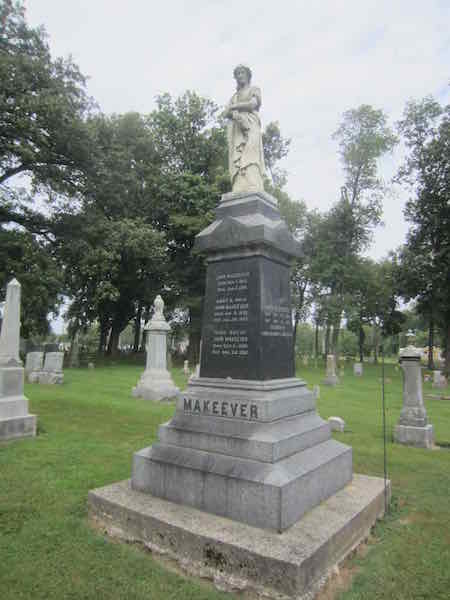
To the east of the Makeever monument is the marker for Israel Washburn, one of Rensselaer's early doctors. He was a surgeon in the Civil War and before moving to Rensselaer served in the Indiana State Legislature. His tombstone features a cooper relief portrait, something unique to Weston Cemetery. It almost certainly was done by his daughter Mary, who was a sculptor and did the Milroy statue in Milroy Park (which is where Milroy's house was once located). His son Ira Washburn practiced medicine in Rensselaer for most of the first half of the twentieth century.
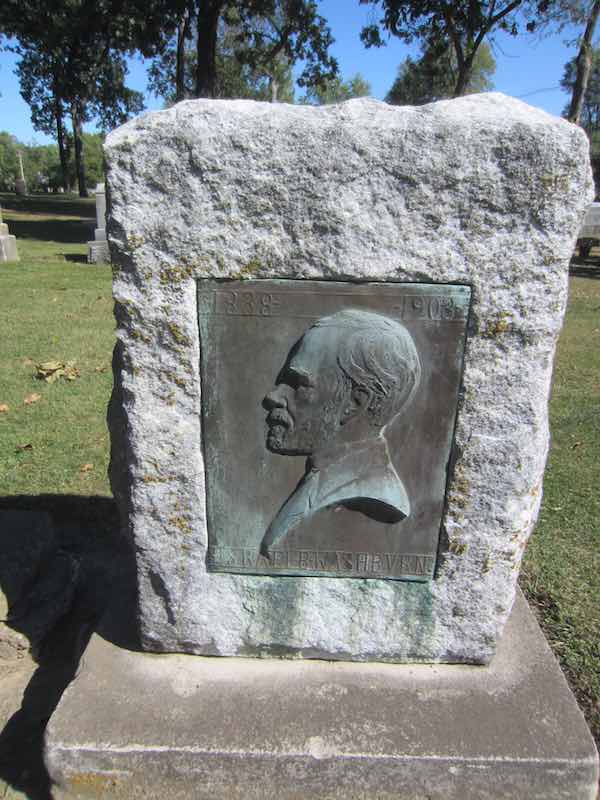
We now head to the north east, looking for a large marker for the Kurrie family. Harry Kurrie practiced law in Rensselaer before becoming a lawyer for the Monon Railroad. He was president of that railroad from 1914 until his death in 1938.
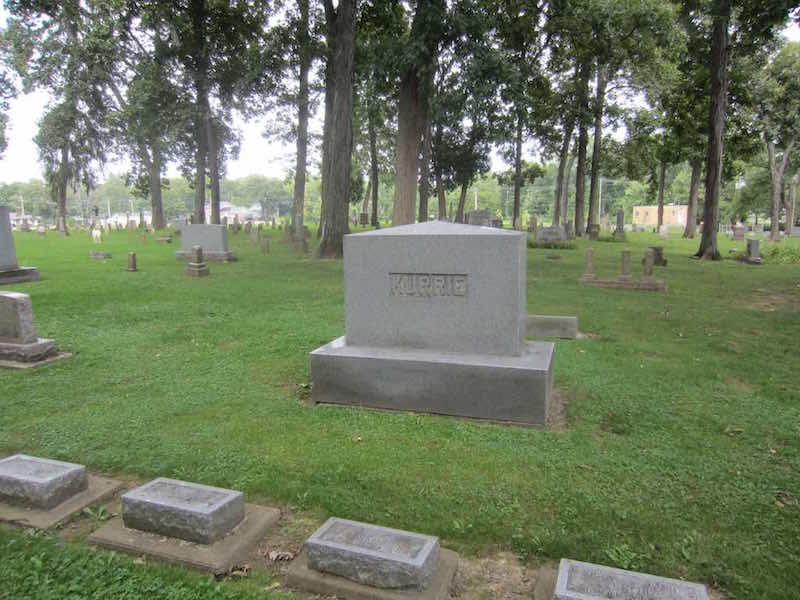
Turning to the northwest, we pass by the very large block of granite that marks the grave of William Baker. A bit beyond are much more modest markers of the Stackhouse family. In this lot is the grave of Eleanor Stackhouse Atkinson, perhaps the most successful author to come out of Rensselaer. (The other contender is Edison Marshall who is buried in Georgia.) She is famous enough to have a Wikipedia entry.

We head to the north and slightly to the west. As we approach the bend in the road, we find one of the many Yeoman markers in the Cemetery, that of David Yeoman. David was the son of Joseph Yeoman, who built the first cabin on the site that is now Rensselaer. Joseph is buried in Old Settlers (Sayler-Makeever) Cemetery east of Rensselaer. There is a plaque on the northeast side of the Washington Street Bridge that commemorates his cabin. David had an interesting life, as the text on the findagrave marker indicates.
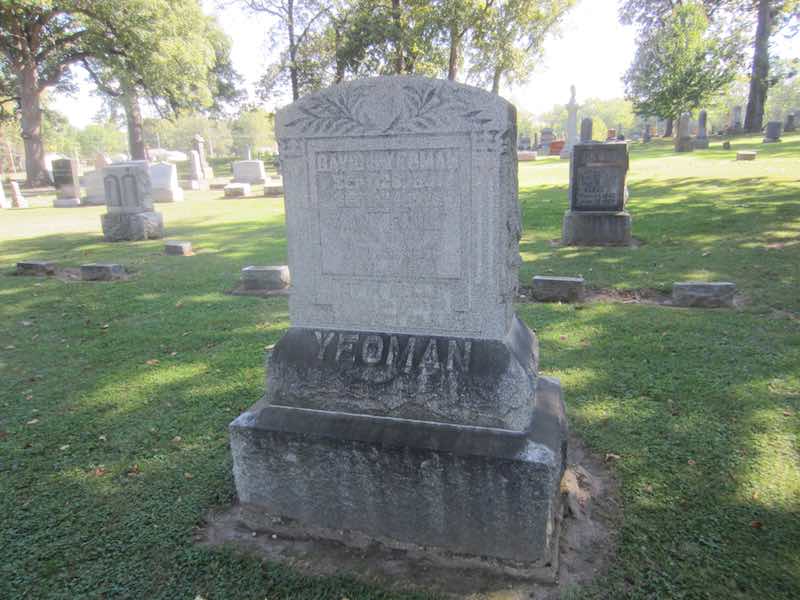
Continuing northwest to the bend in the road, we pass through the Karsner lot. In an unmarked grave is Jerry Karsner, who has a unique obituary. We reach the road and head up the hill. On the west side of the road is Section F, which is only one row deep. When we reach the T in the road, on our left (east) are large monuments of two prominent lawyers who became judges, Edwin P Hammond and Simon P Thompson.
After a three-month Civil War enlistment, Edwin Hammond returned to Rensselaer and in 1861 was elected to the Indiana House. A year later he helped form the 87th Indiana Volunteer Regiment and fought with it at the Battle of Chickamauga, where the unit took heavy casualties. Leading the regiment as a colonel, he marched to the sea with Sherman. He became a circuit judge in 1873 but left that position in mid 1883 when appointed to the Indiana Supreme Court to fill a vacancy. He lost the election to retain the seat in 1884. He briefly worked with his son-in-law William Austin and them partnered with lawyers from Lafayette, moving to Lafayette where he died in 1920.
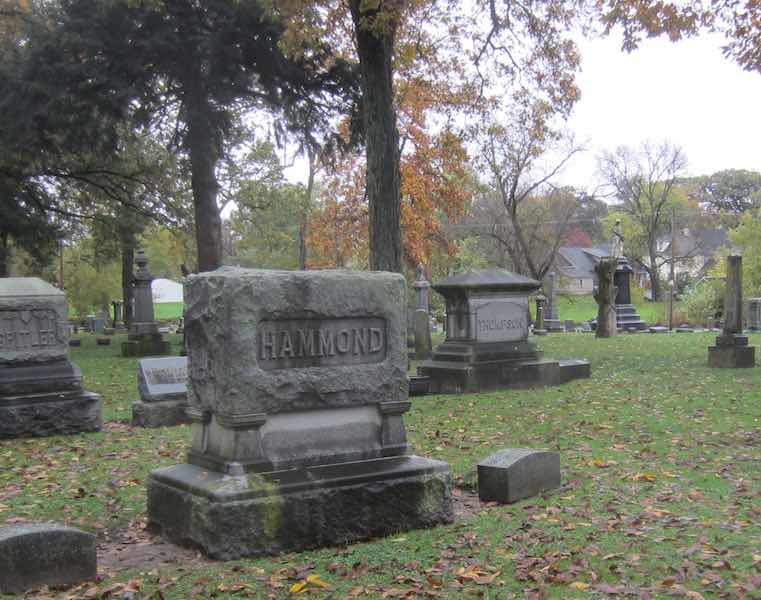
We return to the road and follow it a few yards down the hill, looking to the north into Section U for the marker of George Zorich. He played football in the NLF for the Chicago Bears for a few years, but not long enough to be famous. He married a Rensselaer girl and that is a reason he settled in Rensselaer. He was active on the City Park Board and one of the shelters in Brookside Park bears his name. A more recent Zorich who played for the Bears, Chris Zorich, is not a relative.
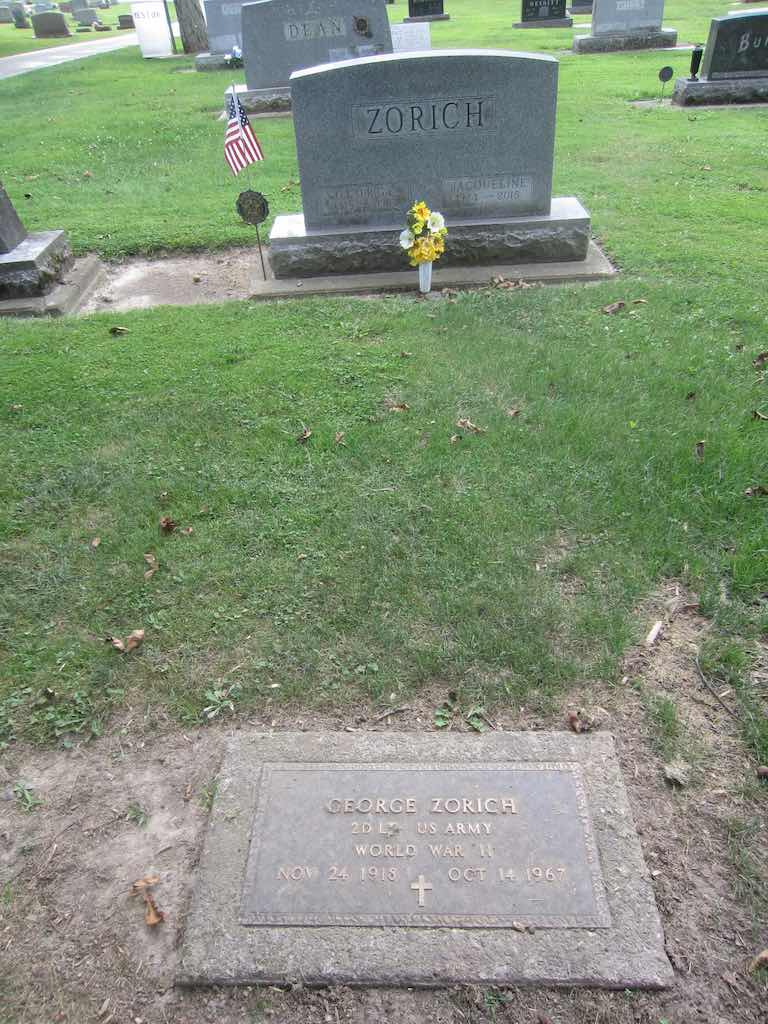
- Introduction
- From the Entrance to Section A
- Sections B and C
- Sections D and U
- Section G
- Across The Creek to The Bridge
- Section P and Westward
- Sections M, L, K and the New Addition
The area around the Makeever monument is full of interesting graves. A short distance to the north is a marker in the form of a tree trunk, the final resting place of Simon and Nancy Phillips and a couple of their children. There are several of these tree-trunk markers in Weston and this is the largest. A Phillips son who is not buried in the family plot went on to become a movie star in the silent film era. Many of the early films have not survived and some of those that did are damaged. None has much appeal to a modern eye; they appear crude and amateurish, as this example featuring Rensselaer's Augustus Phillips demonstrates.
Immediately to the east of John Makeever's grave is that of Micah Halstead, one of a number of Halsteads who were prominent citizens in the early history of the county. Buried on this lot is his son, Edwin Halstead, who was murdered in Dakota territory where he had gone to teach school. Also on the lot are markers for infants that are not mentioned in the burial or death records. It seems likely that many stillbirths were not recorded in the early days of the County.
In the background of the Kurrie picture you can see three small columns close to each other. They mark the graves of three Clifton girls who died of diphtheria in early 1880. Death of children in the nineteenth century was fairly common and there are many graves of children in the older part of Weston Cemetery.
The unfinished tombstone was popular in the late 19th and early 20th century. It could symbolize a life cut short or uncompleted. Almost all images on old gravestone have symbolic meaning. To the south of the Baker monument is that of David Nowels. He was only 13 when he arrived in the wilderness of what was to become Rensselaer with his brother-in-law Joseph Yeoman in 1834. He helped construct the first cabin in Rensselaer. He lived long and prospered.The other enormous monument at the top of the hill is that of William B Austin, a prominent Rensselaer lawyer. He helped found and invested in several early Rensselaer businesses and organizations. In 1898 he hosted a New Years party at which he served champaign. The temperance folks took offense and had him indicted for giving away alcohol on a holiday. On appeal he was cleared.
A bit to the north west of the Stackhouse graves is the grave of Willis Wright and some of his family, another early settler. Willis began his career as a carpenter and then became an undertaker and also opened a furniture store, businesses that stayed in the family for four generations. His son Truitt Parker Wright is buried north and east of Willis. Parker was both an undertaker and coroner when he died of an accidental overdose of some drug. His son W Jennings Wright, buried west of the creek, continued the family business. Buried on the lot with Parker are his daughter Florence Wright Hancock, her husband Victor Hancock, and their son David Hancock. Victor ran a funeral home in Morocco. David Hancock was in the Army Air Corps when he died on a training flight shortly before the onset of WWII.
Today many newspapers do not report suicides. In the past they did, as the case of Nancy Hoyes illustrates. She is buried just to the west of Parker Wright and the Hancocks. Another case of suicide is Albert Hopkins, who is buried between the John Makeever and Simon Phillips graves. The marker is a tiny plaque on a concrete slab.
As we walk from the Stackhouse plot in search of the marker of David Yeoman, we pass close to the grave of Thomas Monnett. His daughter Cordillia Monnett funded the establishment of the Monnett School for Girls that operated in Rensselaer from about 1908 until 1954. Cordillia is buried in Forest Park, Illinois.
Walking up the hill on the road after we leave the Yeoman grave, we pass several lots with Eger burials. Early Egers were in the grocery business. On the back of the southernmost Eger marker, that of Ruth and Harry Eger, is the name James Dean McFall, their grandson. In 1946 he drowned in the Babcock Quarry. He was about eight years old and his death spurred the community to build the LaRue Pool in Brookside Park.